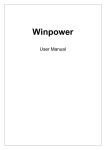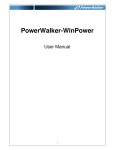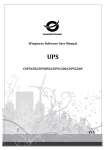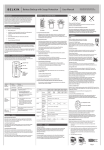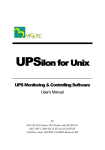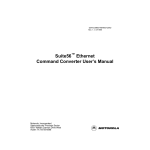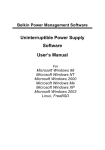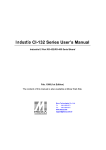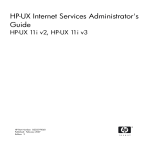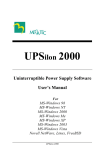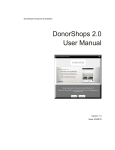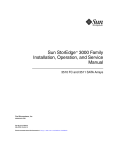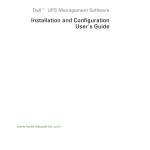Download WinPower
Transcript
WinPower User’s Manual Table of Contents Chapter 1 Winpower Introduction.............................................................................................. 4 1. Winpower profile .................................................................................................................... 4 2. Winpower Structure ................................................................................................................ 4 3. Winpower Application Range ................................................................................................. 5 4. Winpower Functions & Advantages ....................................................................................... 6 Chapter 2 Winpower Installation, Start & Uninstall ............................................................... 8 1. System Requirement ................................................................................................................ 8 2. Winpower Installation Steps ................................................................................................... 8 3. Start/Stop Winpower ............................................................................................................. 14 4. Uninstall Winpower .............................................................................................................. 15 Chapter 3 Winpower User Interface....................................................................................... 19 1. "Winpower Manage" window ............................................................................................... 19 2. Menu and Dialog .................................................................................................................. 20 1) Auto Search UPS .................................................................................................................................. 20 2) “Administrator” Dialog......................................................................................................................... 22 3) "Administrator Password Settings" Dialog........................................................................................... 22 4) "Event log Viewer" Dialog ................................................................................................................... 23 5) "Data log Viewer" Dialog..................................................................................................................... 23 6) “Record Setting” Dialog ....................................................................................................................... 24 7) "UPS Control Parameters" Dialog ........................................................................................................ 27 8) "Event Action" Dialog .......................................................................................................................... 29 9) "Shutdown Settings" Dialog ................................................................................................................. 30 10) "UPS Self-Test Immediately" Dialog ................................................................................................. 33 11) "UPS Test Manager" Dialog ............................................................................................................... 34 12) "UPS On/Off Manager" Dialog .......................................................................................................... 35 13) "Schedule Viewer" Dialog.................................................................................................................. 36 14) "Broadcast Message Settings" Dialog................................................................................................. 37 15) "Email Settings" Dialog...................................................................................................................... 38 16) "SMS Setting" Dialog ......................................................................................................................... 39 17) "Pager Setting" Dialog........................................................................................................................ 40 18) "Monitor Remote UPS" Dialog........................................................................................................... 42 19) Bottom image...................................................................................................................................... 43 20) Temp ................................................................................................................................................... 45 21) Date Format ........................................................................................................................................ 46 22) Advance Settings ................................................................................................................................ 48 23) Language menu................................................................................................................................... 50 24) "Communication Port Settings" Dialog .............................................................................................. 51 Chapter 4 How to do................................................................................................................. 53 1. How to realize the conversion of the appointed COM port? ................................................ 53 2. How to realize broadcasting message in LAN...................................................................... 55 3. How to realize the schedule of adding/Removing UPS self-test ........................................... 57 4. How to realize the schedule of adding/Removing UPS on/off .............................................. 60 5. How to realize the network shutdown function..................................................................... 63 2 6. How to realize Setting up shutdown parameter.................................................................... 64 7. How to realize the modification of UPS control parameter ................................................. 67 8. How to realize system administrator operation and password modifying realize................ 68 9. How to realize sending event message by email................................................................... 69 10. How to realize sending event messages by mobile phone................................................... 72 11. How to realize sending event messages by pager............................................................... 75 12. How to realize telemonitoring any UPS in LAN within the same network......................... 78 13. How to realize remote control of any UPS in different network in LAN ............................ 81 14. How to realize the Remote Control of any one of the UPS in Internet............................... 85 Appendix A—Glossary Explanation ......................................................................................... 89 Appendix B---Winpower Event Table ...................................................................................... 91 3 Chapter 1 Winpower Introduction 1. Winpower profile Winpower is a UPS monitoring software which supports either stand alone computers or network (including LAN & Internet) connected computers. Winpower is used to monitor the intelligent UPS and safeguard computer systems from unexpected crash when power fails. With Winpower software, user can monitor and configure the UPS on any computer in the same LAN. With this software, one UPS can provide multiple computers in network with security protection simultaneously, including shutting down system in security, saving application data and shutting down the UPS when AC fails. 2. Winpower Structure Winpower is made up of three components: Agent, Monitor and TrayIcon. Note:The concrete meaning of Agent refer to Appendix A — glossary explanation. Agent is the core component of Winpower and runs as a system service on background. Communicates with the UPS, logs events, notifies users of events, arranges actions according to user's requirement and impending shutdown when necessary. Also, Agent can be managed by Monitor. Monitor is the user interface application of Winpower. Relying on Agent, it gathers real-time UPS information, UPS status, server information and allows user to tailor the UPS working parameters. It can run on any computer on the LAN or stand alone computer. TrayIcon is the management tool of Winpower. Only in Windows platform has this component. It appears in Status Area of System task bar. TrayIcon has two different icons for displaying current Agent status. The icons and the related status refers to the following table 1-2-1: Indicate the Agent is Stopped. Indicate the Agent is Running. Table 1-2-1 While user right clicks the Manager icon, a shortcut menu will popup. The menu items are listed below: Diagram 1-2-1 The relationship between Agent and Monitor refers to the following Diagram 1-2-2 4 Diagram 1-2-2 3. Winpower Application Range Application of stand alone computers refers to the following Diagram 1-3-1: Diagram 1-3-1 Application in the LAN refers to the following Diagram 1-3-2: (Diagram 1-3-2) Application in the Internet refers to the following Diagram 1-3-3: 5 (Diagram 1-3-3) 4. WinPower Functions & Advantages When Agent start, it will run continuously, protect your equipment in every moment. Uninstall easily and clearly with no trace. Never increase spending on system and is Green software. You can have a panoramic view of all the information. The information of utility power, UPS, loads and battery is shown on the same window and you can take in everything in a glance. With the function of auto searching and telemonitoring any UPS in LAN. With the function of manual searching and telemonitoring any UPS in Internet. With security protection function. The system administrator password can be set to prevent others from sabotaging. Only the system administrator can have the full access, other users can only view. With the function of data auto protection. It can close most of the running applications and save the related files. With the function of time turning on and off the UPS, which can give maximum protection to your computer system. With the function of time self test of the UPS, which provide maximum protection to your UPS system. With the function of network shutdown, which supply your network system maximum protection. With the function of data logging (including UTILITY POWER, UPS, LOAD and BATTERY) and event logging, so that the system administrator can carry out the UPS system daily maintenance. 6 Flexible means of information transfer let you know the UPS status at any moment and at everywhere, never miss any one because of the change of time and place. With the function of broadcasting messages to every users in the network. With the function of sending messages via pager. With the function of sending messages by EMAIL. With the function of sending messages via mobile phone sending SMS. 7 Chapter 2 Winpower Installation, Start & Uninstall 1. System Requirement 128 MB physical memory at least (256MB is recommended). 160 MB at least hard disk space. The user is required to have the access of administrator. More than 256 colors and 800 * 600 resolution or above display is recommended. For Windows, Linux or Unix operating system, the user must have the access of super user. TCP/IP protocol must be installed to support network management. An available communication port (RS-232 Serial Port or USB port) is needed while connecting to UPS with a special communication cable. Platforms supported by Winpower include the following: Windows 98 Windows me Windows NT 4.0 (sp6) Windows 2000 Windows 2003 Windows XP Linux Solaris/Sparc 2.6, 7, 8, 9 Solaris/Intel 2.6, 7, 8, 9 HP-UX 11.x, 11i.x AIX 4.3.x, 5.x Mac PPC OSX Compaq Tru64 Alpha SCO UnixWare 7.1.1, 7.1.3 SCO Unix 8.0 FreeBSD x86 SGI Irix 6.5.x 2. Winpower Installation Steps Enter the right directory of the CD according your platform type. For GUI mode environment: Insert the Winpower CD, find out the operate system of your computer( such as Windows) in the CD directory, Refer to Diagram 2-2-1 below: Diagram 2-2-1 8 For Windows platform, enter \Windows\Disk1\InstData\VM directory, run setup.exe to start the installation. Refer to the following diagram 2-2-2: Diagram 2-2-2 For Mac OS X platform, enter \MacOSX\Disk1\InstData directory, double click the setup.app to start the installation. Refer to the following diagram 2-2-3: Diagram 2-2-3 For other operating system, execute ./setup.bin or setup_console.bin, Refer to the following diagram 2-2-4: Diagram 2-2-4 Read the introduction , Refer to the following diagram 2-2-5 9 Diagram2-2-5 Click “Next”button ,and input the Serial Number, Refer to the following diagram 2-2-6 Diagram 2-2-6 10 Click “Next”button ,and choose install folder , Refer to the following diagram 2-2-7 Diagram 2-2-7 Review the Pre-installation Summary, Refer to the following diagram 2-2-8: 11 Diagram 2-2-8 Installing, Refer to the following diagram 2-2-9: Diagram 2-2-9 When the installation program is completed, click Done. Refer to the following diagram 2-2-10:。 12 Diagram 2-2-10 Clicking on the button “Done”. If the software is installed successful, ”Winpower” application can be found in the Start menu\Programs\, refer to the following diagram 22-11. Diagram 2-2-11 For console mode environment: 1. Enter the directory according the system and run setup.bin or setup_console.bin to start the installation program. Note: For UnixWare platform, make sure JRE1.3.1 has been install in your system, then enter the /GenericUnix directory to start the setup. 2. Read the information provided, then press ENTER to continue the installation. 13 3. When the installation program is completed, click Done. 4. Reboot the Linux and Unix system after installation. The installation will set enviroment variables for Winpower in /etc/profile file.(details see 'Set environment variable' below) Reboot the system in order to make this settings valid. Note: For UnixWare platform, make sure JRE1.3.1 has been install in your system, then enter the /GenericUnix directory to start the setup. 3. Start/Stop Winpower In Windows operating system Start Agent: Run the Winpower form Start\Progrom\Winpower will start the TrayIcon and Agent. Refer to the Diagram 2-3-1 below: Diagram 2-3-1 The Agent can be start by the following 3 methods: 1) Run the Winpower form Start\Progrom\Winpower will start the TrayIcon and Agent.refer to Diagram 2-3-1. 2)Right click the Agent icon showing on the bottom right corner of the display and select the ‘Start Agent’item.refer to Diagram 2-3-2. Diagram 2-3-2 3) For Windows operate system,Agent can be startup automaticallywhen the computer startup. Start Monitor: Method One: Right click the TrayIcon and select the "Start Monitor" menu item.refer to Diagram 2-3-3. 14 Diagram 2-3-3 Stop the Agent: Right click the TrayIcon and select the "Stop Agent" menu item. Refer to the following diagram 2-3-4 Diagram 2-3-4 In Mac OS X Start Agent: Agent is auto stated on system boot. You can also start it by enter install directory and execute command: ./agent start Start Monitor: Double click the executable monitor link in "Applications/Smart Power" directory to start Monitor. You can also start it in terminal by enter install directory and execute command: ./monitor Stop Agent: Enter install directory and execute command: ./agent stop In Linux and UnixWare: Start Agent: enter /opt/upspilot directory and execute command: ./agent start Start Monitor: enter /opt/upspilot directory and execute command: ./monitor Stop Agent: enter /opt/upspilot directory and execute command: ./agent stop 4. Uninstall Winpower In Windows operating system There are two kinds of methods for Uninstalling Winpower One is to click “Uninstall Winpower” icon in “Start/Program/Winpower” with left mouse button, refer to Diagram 2-4-1 below: 15 Diagram 2-4-1 The other one is to left click “Control Panel/”Add/Remove Program”/Change/Remove(C)” button, see Diagram 2-4-2 below: Diagram 2-4-2 Note: Before uninstall Winpower,your must stop all Winpower program first! Otherwise it can't be uninstall completely. After left click, the Uninstall Program will pop up a dialog shown on Diagram 24-3 as below: 16 Diagram 2-4-3 Click the “Uninstall” button to begin to uninstall Winpower software, refer to the following diagram 2-4-4 Diagram 2-4-4 17 Click “Done” button and Winpower has been uninstalled completely. Refer to the following diagram 2-4-5 Diagram 2-4-5 Note:Before uninstall Winpower,your must stop all Winpower program first! Otherwise it can't be uninstall completely. In Mac OS X: Double click the Uninstall link in "Applications/Winpower" directory or enter "/opt/upspilot" directory and execute command: ./Uninstall In Linux and UnixWare: Open the Terminal, enter "/opt/upspilot" directory and execute command: ./Uninstall 18 Chapter 3 Winpower User Interface 1. "Winpower Manage" window Winpower Monitor shows "Winpower Manager" window which display a list of all Agents within the LAN. There is a tree view on the left side of the window that displays a hierarchical list of items, such as ‘Root’,‘networks’,the Agents,the COM port,USB port and the UPS models. By clicking an item, the user can expand or collapse the associated list of subitems, Refer to the following diagram 3-1-1: Diagram 3-1-1 If you select one of the UPS model from the UPS List, details about the UPS will be displayed on the right side, Refer to the following diagram 3-1-2: 1. The middle area displays the UPS Status Figure. The UPS Status Figure is different for various UPS status and UPS type. 2. The upper area displays the UPS Status Description and recommendation, and the Agent system times with right align. 3. The lower area displays the last two events information. 4. It is able to minimize the window by clicking the minimum button on the top right corner of the window. 5. It is able to exit from the system by clicking “X”. 19 Diagram 3-1-2 Illustration for UPS Status information bar: The UPS status figure consists of five parts: AC LINE, UPS, BATTERY,LOAD and BYPASS. Each part is connected with power cord. 2. Menu and Dialog 1) Auto Search UPS When user select " Auto Search UPS " menu item from "System" Menu, Winpower will start searching for the UPS connect with the computer’s serial port. See the following diagram 3-2-1-1 and diagram 3-2-1-2. Diagram 3-2-1-1 20 Diagram 3-2-1-2 By clicking the item in the tree view,user will get the information as below, see the following diagram 3-2-1-3: 1) All the computer running Winpower Agent on the LAN. 2) UPS COM Port or USB Port. 3) the model type of UPS to which the Agent is connecting. 4) The Current Status of the Agent which user select in the tree view . 21 Diagram 3-2-1-3 2) “Administrator” Dialog "Administrator" dialog can be opened by clicking “Act as Administrator” in the “System” menu. See the following diagram 3-2-2. Enter the administrator password in the edit box and then click “OK” button. If the password is not correct, the system will pop up a message dialog to prompt users that the user password is not correct. If the password is correct, users can get the administrator access right and set up the Agent. Note :Initial password is “Administrator”. Diagram 3-2-2 3) "Administrator Password Settings" Dialog “Administrator Password Settings” dialog can be opened from the “Modify Administrator Passowrd” menu item of “System” menu. Refer to the following diagram 3-2-3: Diagram 3-2-3 Administrator password only can be set by super user in local machine. If your are not an super user yet, the "Administrator" Dialog will pop up first for you to log on as administrator. Users need to enter a new password in the "New Password" text box and reenter the new password in the "Confirm Password" text box. If the passwords are not consistent with each other, a message dialog will pop up to notify the users that the password is not correct and request the users to enter it once again. If the passwords are consistent with each other and the button "OK" is selected, the new password will be accepted by the system. 22 4) "Event log Viewer" Dialog "Event Log Viewer" Dialog will show when user select "Event Log" menu item from "Logs" Menu or click buttons from toolbar, or click the “View log” button of event log in the “Record Setting” dialog, then the “Event Log” dialog will pop up. See the following Diagram 3-2-4. The dialog displays a list of history events. Diagram 3-2-4 User can select the check box “Delete” and click "Delete" button to remove the selected events. Users can click “Close” button to close the dialog. Users can click "Purge All" button to delete all of the events. Note: If “Delete” and "Purge All" button is in invalid condition, which means your access right to the current Agent is “Read Only”, you can not carry out the operation. You may log in as super user through the “Act as Administrator” menu. 5) "Data log Viewer" Dialog "Data Log Viewer" Dialog will popup when users select "Data Log" menu item from "Logs" Menu , or click buttons from toolbar or click “View log” button of data log in the “Record Setting” dialog. Refer to the following Diagram 3-2-5, the history data will appear in this dialog. Users can click “Next”, “Prev”, “Home” and “End” button to display the data log. 23 Diagram 3-2-5 User can select the check box “Delete” and click "Delete" button to remove the selected data log. Users can click “Close” button to close the dialog. Users can click "Purge All" button to delete all of the data. Note: If “Delete” and "Purge All" button is in invalid condition, which means your access right to the current Agent is “Read Only” and you cannot carry out these operations. You may log in as super user through the “Act as Administrator” menu. 6) “Record Setting” Dialog “Record Setting” dialog can be opened from the “Record Setting” menu item of “Logs” menu. Refer to the following Diagram 3-2-6-1: Diagram 3-2-6-1 The default value of the maximum file length of Event Log Viewer is 32KB (The maximum value is 1MB) Click the “View Log” button of the event log in the “Record Setting” dialog (Refer to the following Diagram 3-2-6-2) to pop up the “Event Log Viewer” dialog (Refer to the following diagram 3-2-6-3) 24 Diagram 3-2-6-2 Diagram 3-2-6-3 Click the “Settings” button of the event log in the “Record Setting” dialog (Refer to the following diagram 3-2-6-4) to pop up the “Event Action” dialog, refer to the following diagram 3-2-6-5. 25 Diagram 3-2-6-4 Diagram 3-2-6-5 The default value of the “Maximum file length” in the “Data Log Viewer” is 32KB (the maximum is 1MB). The default value of record interval in the “Data Log Viewer” is 60 second (the maximum is 3600 second). Click the “View Log” button of data log in the “Record Setting” dialog (refer to the following diagram 3-3-5-6) to pop up the “Data Log Viewer” dialog (refer to the following diagram 3-2-6-7). 26 Diagram 3-2-6-6 Diagram 3-2-6-7 Note: Click “Default” button and the parameters in this page will become default. If the “OK” button is in invalid condition, which means your access right to the current Agent is “Read Only” and you cannot setup the parameters. You may log in as a super user through the “Act as Administrator” menu. 7) "UPS Control Parameters" Dialog "UPS Control Parameters" Dialog will pop up when user select "UPS Control Parameters" item from “UPS” menu. For ON-LINE UPS,Refer to the following diagram 3-2-7-1: 27 Diagram 3-2-7-1 See the following table 3-2-7: Parameter High limit of input frequency on bypass Unit Hz - Maximum 60.0 (for 50Hz system) 70.0 (for 60Hz system) 49.0 (for 50Hz system) 59.0 (for 60Hz system) 286 (for 1~3K 220V UPS) 132 (for 1~3K 110V UPS) 261 (for 6~20K UPS) 219 (for 1~3K 220V UPS) 110 (for 1~3K 110V UPS) 209 (for 6~20K UPS) - Minimum 51.0 (for 50Hz system) 61.0 (for 60Hz system) 40.0 (for 50Hz system) 50.0 (for 60Hz system) 221 (for 1~3K 220V UPS) 110(for 1~3K 110V UPS) 231 (for 6~20K UPS) 80 (for 1~3K 220V UPS) 40 (for 1~3K 110V UPS) 140 (for 6~20K UPS) - Default 54.0 (for 50Hz system) 64.0 (for 60Hz system) 46.0 (for 50Hz system) 56.0 (for 60Hz system) 264 (for 1~3K 220V UPS) 132 (for 1~3K 110V UPS) 261 (for 6~20K UPS) 80 (for 1~3K 220V UPS) 50 (for 1~3K 110V UPS) 176 (for 6~20K UPS) Yes Low limit of input frequency on bypass Hz High limit of input voltage on bypass V Low limit of input voltage on bypass V ON button can control battery mode audible warning OFF button can control bypass - - - Yes (for 1~3K UPS) 28 mode audible warning Do audible warning when on bypass mode Do audible warning when on battery mode Restore line mode when AC restored Work on bypass when UPS turned off - - - No (for 6~20K UPS) Yes - - - Yes - - - Yes - - - No (for 1~3K UPS) Yes (for 6~20K UPS) table 3-2-7 Note: To press the “default” button, the parameters in this page will become the default value. For LINE-INT UPS, user can enable/disable battery mode alarm audible though this dialog. Refer to the following diagram 3-2-7-2: Diagram 3-2-7-2 Note: If the “OK” buttons are in invalid condition, which means that your access right to the current Agent is read only and you cannot carry out setup. You may log in as a super user via the “Act as Administrator” menu. 8) "Event Action" Dialog “Event Action” dialog can be opened by clicking “Event Action” menu item in the “UPS“ menu or buttons in the toolbar. Refer to the following diagram 3-2-8. In the “Event Action” dialog, users can select which action to be carrying out when some events occur. For every event, the actions users can select including: Record, Broadcast, Email,Send SMS and Send Pager users. 29 Diagram 3-2-8 Events are divided into three types of icons: Severity (red), Warning (yellow) and Message (blue). Note: to use the e-mail function, you must setup SMTP server. For the detailed information please refer to “How to realize sending event message by e-mail”. 9) "Shutdown Settings" Dialog The “Shutdown settings” dialog can be opened from the “Shutdown Parameter” menu item in the “UPS” menu. Refer to the following diagram 3-2-9: 30 Diagram 3-2-9 In the “Shutdown Settings” dialog, the parameters which can be setup is shown in the following Table 3-2-9: Parameter Unit Battery Minute backup time Shutdown System __ Maximum Value 4320 Minimum Value 1 Default Remark 10 The time that the UPS's battery is able to supply power when utility power fails. __ __ No When this check box is selected, System will be shutdown while the appointed UPS is being turn off. 31 Suspend System __ __ __ System shutdown need time Minute 99 1 Remote Shutdown by Agent __ __ __ XX min shutdown system Minute 4320 0 Run Command File before Shutdown __ __ __ Shutdown File Max Execution Time Minute 60 1 Begin __ __ __ No When this radio box is selected, System will be suspend to disk in shutdown sequence. This function only can be carry out in some Windows platforms and hibernate support must be enabled from /Control Panel/Power Options/Hibernate . 2 The time to be needed to shutdown the system, which is from the beginning of shutting down to the end of that. No If Yes, System enable be shutdown by specified Agent. 0 Receive the specified agent's shutdown signal,delay XX min shutdown system . Nothing Before system shutting down, Agent can execute a file, if this parameter is not a naught, Agent will not begin to shut down the system until the "Execution file before system shutting down" ends. 1 Before system shutting down, the time to be needed to execute the shutdown file. Yes When this check 32 Shutting down immediately while battery low Shutdown remote Agents' Conditions __ __ __ __ Agents be Shutdown __ __ __ __ Shutdown Alarm Interval Minute 60 1 1 Start Warning before Scheduled Shutdown Minute 60 1 10 box is selected and battery low event occurs, Agent will shut down the UPS immediately, otherwise the shutting down time will be controlled by battery back up time. The condition can be "UPS be shutdown" or "The time on battery exceed setting time" . When shutdown condition is satisfied, Agent will send shutdown signal to the appointed remote Agents. The interval that Agent pop up an alarm message before shutting down. If user has setup schedule shutting down, AGENT will sound alarm prior to the set time. Table 3-2-9 Note: If the “OK” button is in invalid condition, which means your access right to the current Agent is “Read Only” and you cannot setup the parameters. You may log in as super user through the “Act as Administrator” menu. 10) "UPS Self-Test Immediately" Dialog “UPS Self-Test Immediately” dialog can be opened from the “Battery Self-Test Now” menu item of “UPS” menu. Refer to the following diagram 3-2-10: 33 Diagram 3-2-10 In the “UPS Self-Test Immediately” dialog, users can select the type of self test: SelfTest for 10 seconds, Self-Test until battery low, Self-Test for XX minutes. The time range of self test for XX minutes is from 1 to 99 minutes. Note: If the “OK” button is in invalid condition, which means that your access right to the current Agent is read only and you cannot carry out these operations. You may log in as a super user through the “Act as Administrator” menu. 11) "UPS Test Manager" Dialog “UPS Test Manager” dialog can be opened from the “Battery Self-Test Schedule” menu item of “UPS” menu. Refer to the following diagram 3-2-11: Diagram 3-2-11 34 “UPS Test Manager” can be used to display and setup UPS self test task. UPS self test task which can be set includes two types “once” and “monthly”. UPS self test type which can be set includes UPS self test for 10 seconds, UPS self test to battery low, UPS self test for the appointed time. The appointed time range for UPS self test is 1 to 99 minutes, and the default value is 10 minutes. “UPS Test Manager” dialog consists of two parts, task list and calendar. All of the UPS self test and UPS on/off tasks are shown in the calendar. The red dot denotes the Power Off action, the green dot denotes the Power On action and the blue dot denotes the self test action. Click the “Add Test” button and users can setup the special time and monthly UPS self test task in the popped up dialog. The added self test will be entered the schedule. If you select one of the UPS self test tasks in the task list, you may modify the task that has been set in the popped up dialog by clicking the “Modify” button. If you select one of the UPS self test tasks in the task list, you may remove this task by clicking “Remove” button. Note: If the “OK”, “Add Test”, “Modify” and “Remove” buttons are in invalid condition, which means that your access right to the current Agent is read only and you cannot carry out setup. You may log in as a super user via the “Act as Administrator” menu. 12) "UPS On/Off Manager" Dialog “UPS On/Off Manager” dialog can be opened from the “UPS On/Off Schedule” menu item of “UPS” menu. Refer to the following diagram 3-2-12: Diagram 3-2-12 35 “UPS OnOff Manager” dialog is used to display and set up UPS On/Off tasks. The UPS On/Off tasks that can be set include two types “Once” and “Weekly”. The UPS Power Off time range (from shutdown to turning on next time) that can be set is 1-9999 minutes, i.e. the longest power Off time is 6 days 22 hours and 39 minutes. The input range for the year is 2002-2035. “UPS OnOff Manager” dialog consists of task list and calendar. All of the UPS self test and UPS OnOff tasks are shown in the calendar. We use red dot to denote the Power Off action, green dot to denote the Power On action and blue dot to denote self test action in the calendar. Users can setup weekly and special time’s UPS Power On/Off tasks in the popped up dialog by clicking “Add UPS shutdown” button. Note: In terms of time, the new added task cannot conflict with the UPS self test task and UPS Power On/Off tasks which have been set. If you select one of the UPS self test tasks in the task list, you may modify the setup task in the popped up dialog by clicking the “Modify” button. You may also remove this task by clicking “Remove” button. Note: If the “OK”, “Add Test”, “Modify” and “Remove” buttons are in invalid condition, which means that your access right to the current Agent is read only and you cannot carry out setup. You may log in as a super user via the “Act as Administrator” menu. 13) "Schedule Viewer" Dialog “Schedule Viewer” dialog can be opened from the “View Schedule” menu item of the “UPS” menu. Refer to the following diagram 3-2-13: Diagram 3-2-13 “Schedule Viewer” dialog is used to show the set up UPS Power On/Off and self test tasks. “Schedule” dialog consists of task list and calendar graphic. Only the tasks of the current month are displayed in the task list. We use red dot to denote the Power Off 36 action, green dot to denote the Power On action and blue dot to denote the self test action in the calendar. 14) "Broadcast Message Settings" Dialog “Broadcast Message Settings” dialog can be opened from the “Broadcast Setting” menu item of “Tools” menu or click broadcast “Setting” button in “Event Action” Dialog. Refer to the following diagram 3-2-14: Diagram 3-2-14 "Broadcast To" list box list the users. The user item must be selected if it want to receive broadcast message. You can add and delete user items by click "Add" and "Remove" button (Note: the "All Users" and "Domain User" item can not be deleted). "All Users" means all computers in LAN. "Domain User" means computers in the same domain with local Agent. "Send message" list box list the messages to be sent. You can select or unselect the message by click the message item. 37 Note: This settings only valid in Windows platform. If the "OK" button is in invalid condition, which means your access right to the current Agent is "Read Only" and you cannot carry out these operations. You may log in as a super user through the "Act as Administrator" menu. Only in Windows platform can carry out broadcast function. To receive broadcast message, "Winpopup" in Windows95/98 and "Messenger Service" in Windows NT/2000 must be started. 15) "Email Settings" Dialog “EMail Settings” dialog can be opened from the “EMail Setting” menu item of “Tools” menu or click EMail “Setting” button in “Event Action” Dialog. Refer to the following diagram 3-2-15: Diagram 3-2-15 The included items of the email parameter setting are shown in the following Table 3-215: 38 SMTP Server Name SMTP Account Name Password This is the mail server, which is used to send emails to the appointed users. Enter the IP address of the SMTP mail server here. For example, smtp.163.com This is the account number for logging in the server. Enter the complete address format here. For example, [email protected] Input the SMTP account password in needed. Table 3-2-15 “Receiver EMail Address” list box list the email addresses which will receive the email. Click "Add" button to add an email address item. Select an address item and click "Remove" button will delete this item. Selected an email address item and click the "Test" button will send a test email to this email address. “Send message” list box list the messages to be sent. You can select or unselect the message by click the message item. All of the SMTP parameter default value is naught, and it can only be setup in the local Agent. To send email to the appointed user, the SMTP server name or IP address must be set, or the email will not be sent out. Note: If you want to send email via Internet, you must have a SMTP account number in the Internet. If the “OK” button is in invalid condition, which means that your access right to the current Agent is read only and you cannot carry out the parameter setting. You may log in as a super user through the “Act as Administrator” menu. 16) "SMS Setting" Dialog “SMS Setting” dialog can be opened from the “SMS Setting” menu item of “Tools” menu or click Send SMS “Setting” button in “Event Action” Dialog. Refer to the following diagram 3-2-16: 39 Diagram 3-2-16 Below is the use remark of SMS setting: 1. Sender SMS is sent through GSM modem or mobile phone whick connect with your computer. User should select COM port which is being used by GSM Modem or mobile phone. Then set baud Rate of this COM port. 2. Receiver: is the mobile phones numbers which can receive the SMS. It can be one or more. If the Event that you have selected occur Winpower will send the short message to the all phone numbers in the "Receiver" list. 3. Send message User can select the events which need to inform by SMS. Note: If the OK button is in invalid condition, which means your access right to the current Agent is "Read Only" and you cannot carry out these operations. You may log in as a super user through the "Act as Administrator" menu. 17) "Pager Setting" Dialog “Pager Setting” dialog can be opened from the “Pager Setting” menu item of “Tools” menu or click SendPager “Setting" button in ""Event Setting" Dialog. Refer to the following diagram 3-2-17: 40 Diagram 3-2-17 To configure the pager parameters user must have full access. User can get full access by selecting "Administrator" menu item from "Setup" menu and providing right Agent Password in the popup dialog. See the following table 3-2-17: Parameter Description Modem Port Select COM port which is being used by Modem. Access Number For some pager service, a delay is needed between dialing access number and Pager Number. Pager Number For some pager service, a delay is needed between dialing pager number and message code. dailing number to exterior line For extension line, it is always necessary to dial a specified number and delay a specified time to access Exterior Line. dailing number after For some pager service, need to dial a specified message number to end message code. Event Code The event code is dialed as the message code and will be displayed on pager. Table 3-2-17 Note: If the “OK” button is in invalid condition, which means your access right to the current Agent is “Read Only” and you cannot carry out these operations. You may log in as a super user through the “Act as Administrator” menu. 41 18) "Monitor Remote UPS" Dialog "Monitor Remote UPS" Dialog will show when user select "Monitor Remote UPS" menu item from "Monitor" menu. Refer to the following diagram 3-2-18-1: Diagram 3-2-18-1 Enter the IP address of an Agent to be monitored and press OK button. If this agent exist it's information will be displayed below the "WAN" node in the tree view of Manager window. Note: 1) The maximum of remote agent can be monitored is 32. 2) If Winpower can't communicate with a remote agent in 6 minutes, this agent will be deleted automatically. 3) You can manually delete a remote agent by select this agent node below "WAN", then click the mouse right button to show a delete pop up menu, select "Delete" menu item to remove it. Refer to the following diagram 3-2-18-2: Diagram 3-2-18-2 42 19) Bottom image f you select the submenu “BottomImage” of the menu item “Preference”, you can change the bottom image of the interface. Select “None”, the interface is shown as the following diagram 3-2-19-1: Diagram 3-2-19-1 Select “Color”, the interface is shown as the following diagram 3-2-19-2: Diagram 3-2-19-2 Select “Gradient”, the interface is shown as the following diagram 3-2-19-3: 43 Diagram 3-2-19-3 Select “Text”, the interface is shown as the following diagram 3-2-19-4: Diagram 3-2-19-4 Select “Grid”, the interface is shown as the following diagram 3-2-19-5: 44 Diagram 3-2-19-5 Select “Picture”, the interface is shown as the following diagram 3-2-19-6: Diagram 3-2-19-6 20) Temp You can make the interface show the centigrade or Fahrenheit temperature by selecting the submenu “Temp” of the menu “Preference”. If selecting “C”, the interface is shown as the following diagram 3-2-20-1 45 Diagram 3-2-20-1 If selecting “F”, the interface is shown as the following diagram 3-2-20-2 Diagram 3-2-20-2 21) Date Format You can change the displayed date format by selecting the submenu “DateFormat” of the menu “Preference”. The date is displayed with the format “Year/Month/Date”. Refer to the following diagram 3-2-21-1: 46 Diagram 3-2-21-1 To display the date with the format “Month/Date/Year”, refer to the following diagram 3-2-21-2: Diagram 3-2-21-2 To display the date with the format “Date/ Month/Year”, refer to the following diagram 3-2-21-3: 47 Diagram 3-2-21-3 22) Advance Settings You can change the font, size, color and bottom image of the interface by selecting the submenu “Advance Settings” of the menu ”Preference”. “Advance Settings” dialog consists of two views “General” and “BottomImage”. In the “General” view you can change the color of general text, data and warn text by clicking the color you want. Users can select font from the “Font” list. Refer to the following diagram 3-2-22-1: 48 Diagram 3-2-22-1 Note: If you click “Default” button, the parameters in this view will be turned into default value. If the “OK” button is in invalid condition, which means that your access right to the current Agent is Read Only and you cannot carry out the parameter setup. You may log in as a super user through the “Act as Administrator” menu. In the “BottomImage” view: If you click “None” box, the bottomimage of the interface is “background color”. Users can select the color that they want by clicking “Color” box Users can select the color and gradient direction that they want by clicking “Gradient” box Users can select background color, character size and light and shade degree of background text by clicking “Text” box. The bottom image is the background that has the appointed text. Users can select the background color, the grid offset, the grid size and the grid light and shade degree in the background by clicking “Grid” box, the bottom image of the interface is “Grid”. Users can select the background pictures from the popped up list box by clicking the “Picture” box, the bottom image of the interface is “Picture”. 49 Refer to the following diagram 3-2-22-2 Diagram 3-2-22-2 Note: Click “Default” button, the parameters in this view will turn to default value. If the “OK” button is in invalid condition, which means that your access right to the current Agent is Read Only and you cannot carry out the parameter setup. You may log in as a super user via “Act as Administrator” menu. 23) Language menu Users can select languages in the “Language” menu to make the interface display text in “English”, “German” , “French” , “Italian” ,”Spanish”, “Turkish” or “Portuguese”. Refer to the following diagram 3-2-23 50 Diagram 3-2-23 24) "Communication Port Settings" Dialog "Communication Port Settings" dialog can be opened from the "COM Port Setting" menu item of "System" menu. For Linux and Unix platform, Winpower can't auto detect the Serial Port Devices. If the System has a Serial Port not be found in the default setting table, you must add it by manually in the "Communication Port Settings" dialog before using it. following Table following diagram 3-3-24: Diagram 3-2-24 The default Serial Port Devices setting: following Table following Table 3-3-23: Platform Linux Solaris HP-UX AIX UnixWare Tru64 FreeBSD Serial Port Devices /dev/ttyS0 /dev/ttyS1. /dev/ttya /dev/ttyb /dev/tty0p0 /dev/tty1p0 /dev/tty0p1 /dev/tty0p2 /dev/tty0 /dev/tty1 /dev/tty1A /dev/tty2A /dev/tty00 /dev/tty01 /dev/ttyd0 /dev/ttyd1 51 Table 3-2-24 Note: If the "OK" button is in invalid condition, which means that your access right to the current Agent is read only and you cannot carry out the parameter setting. You may log on as a super user through the "System" menu. 52 Chapter 4 How to do 1. How to realize the conversion of the appointed COM port? When the PC with Winpower has multiple serial ports, Winpower can allow the users to change the current connected serial ports of the UPS via “Auto search UPS” menu. See the following Diagram 4-1-1: Diagram 4-1-1 There is a tree view in the left displays a hierarchical list of items , such as ‘Root’,‘networks’,the Agents,the COM port and the UPS models. By clicking an item, the user can expand or collapse the associated list of subitems, Refer to the following diagram 4-1-2: 53 Diagram 4-1-2 When user select a UPS model ,"Manager" Window will show details about the UPS in the right . For Linux and Unix platform, Winpower can't auto detect the Serial Port Devices. If the System has a Serial Port not be found in the default setting table, you must add it by manually in the "Communication Port Settings" dialog before using it. See the following Diagram 4-1-3: Diagram 4-1-3 The default Serial Port Devices setting: following Table following Table 4-1-1: Platform Linux Solaris HP-UX AIX UnixWare Tru64 FreeBSD Serial Port Devices /dev/ttyS0 /dev/ttyS1. /dev/ttya /dev/ttyb /dev/tty0p0 /dev/tty1p0 /dev/tty0p1 /dev/tty0p2 /dev/tty0 /dev/tty1 /dev/tty1A /dev/tty2A /dev/tty00 /dev/tty01 /dev/ttyd0 /dev/ttyd1 54 Table4-1-1 Note: For the first time start Agent it takes more time than later to communicate with the UPS.And the softerware will keep a record of UPS information.Next time ,Winpower will start according to the last record. If UPS COM Port ,UPS model or slave address being changed,user should click "Auto Search Local UPS" menu item from "System" Menu and get correct UPS information. 2. How to realize broadcasting message in LAN Winpower has the function of sending the event message to the customers in time via Windows message service. The concrete operation refers to the notes in Section 13 of Chapter 3 (“Broadcast Message Settings” Dialog) and Appendix B (Winpower Event Table). See the following diagram 4-2-1: Diagram 4-2-1 With reference to the range of broadcasting, there are altogether three options: all users, Domain users and special users. All users indicate that the message will be sent to all PCs that are in the same network with this PC, no matter whether it is in the same domain with it. Domain users indicate that the message will be only sent to all PCs that are in the same NT domain with this PC. 55 Special users indicate that the message will only be sent to one or a group of defined users, but not others any more. To realize this function, you should set up the “Add Brdoadcast User” dialog first, see the following diagram 4-2-2: Diagram 4-2-2 In the above dialog, after setting up the information of users who will receive messages, select “OK” button to exit from the setup of special users. The names of the setup users will be displayed in the “Broadcast Message Settings” dialog. Select the events that will be sent to the users. After pressing the “OK” button, they will become effective. See the following diagram 4-2-3: Diagram 4-2-3 56 Note:Only in Windows platform can carry out broadcast function. To receive broadcast message, "Winpopup" in Windows95/98 and "Messenger Service" in Windows NT/2000 must be started. 3. How to realize the schedule of adding/Removing UPS self-test Open the “Battery Self-Test Schedule” menu from “UPS” menu to popup the “UPS Test Manager” dialog. See the following diagram 4-3-1: Diagram 4-3-1 Note: If the “OK” button of the dialog is in invalid condition, which indicates that your access to the current Agent is “Read Only” and you cannot setup it. You may log in as a super user from “Act as Administrator” menu. Add the task of UPS self-test Press the “Add test” button to popup the “UPS Self-test” dialog. See the following diagram 4-3-2: 57 Diagram 4-3-2 In this dialog users can make a choice in setting UPS self-test task as in a special time or monthly from the options of “once” or “monthly” in the combo box. You may set the start time of UPS self-test in date and time combo box. Note: the new self-test task cannot conflict with the UPS self-test task that has already been set and the task of UPS Power on/off. You can set the time span of self-test by selecting one of the buttons. It is able to be : Self-test for 10 seconds Self-test until the battery is in low capacitance Self-test for 1 to 99 minutes Press the “Cancel” button, the dialog will be closed and the setting above is invalid. Press the “Ok” button, the dialog will be closed and the task setting will present to the task list. See the following diagram 4-3-3: 58 Diagram 4-3-3 Press the “OK” button to finish saving the setting. See the diagram 4-3-3. Modifying UPS self-test task Select one of the UPS self-test tasks in the task list. Press “Modify” button to modify the task that has been set in the popup dialog. See the following diagram 4-3-4: Diagram 4-3-4 After the modification is finished, press “OK” button to save it. Remove UPS self-test task 59 Select one of the UPS self-test tasks in the task list. Press “Remove” button to cancel the task. See the following diagram 4-3-5: Diagram 4-3-5 4. How to realize the schedule of adding/Removing UPS on/off Open the “UPS OnOff Manager” menu from the “Control” menu to popup the “UPS OnOff Manager” dialog. See the following diagram 4-4-1: 60 Diagram 4-4-1 Note: If the “OK” button of the dialog is in invalid condition, which indicates that your access to the current Agent is “Read Only”, and you cannot set up it. You may log in as a super user via “Act as Administrator” menu. Add the task of UPS OnOff Press “Add UPS OnOff” button to popup “Off UPS” dialog. See the following diagram 4-4-2: Diagram 4-4-2 In this dialog, users can make a choice in the setting of UPS Power OnOff weekly or in a special time via the option of “Once” or “Weekly” in the combo box. Set up the UPS off and restart time in the date and time combo box. Note: the new task of UPS OnOff cannot conflict with the UPS self-test and UPS OnOff tasks that have been set on the time. Press the “Cancel” button, the dialog will be closed and the above settings are invalid. Press “Ok” button, the dialog is closed and the task settings will present to the task list. See the following diagram 4-4-3: 61 Diagram 4-4-3 Press the “OK” button to finish saving the settings. See the following diagram 4-4-3. Modify the task of UPS OnOff Select one of the UPS OnOff tasks in the task list, press “Modify” button to modify the tasks that have been set up in the popped up dialog. See the following diagram 4-4-4: Diagram 4-4-4 After the modification is completed, press the “OK” button to save it. 62 Remove the UPS OnOff task Select one of the UPS OnOff tasks in the task list, press “Remove” button to remove the task. See the following diagram 4-4-5: Diagram 4-4-5 5. How to realize the network shutdown function Open the “Shutdown Parameter” menu item from the “UPS” menu to popup “Shutdown Settings” dialog. See the following diagram 4-5-1: 63 Diagram 4-5-1 Remote Shutdown by Agent: Click “Add” button in the ”Shutdown Options”, enter IP address of agent in the pop up dialog. Press the “OK” button to finish the setting. After this, When the local Agent received the specified agent's shutdown signal, system can be shutdown in delay time. Shutdown Remote Agents: Click “Add” button in the ”Shutdown Remote Agents”, config the shutdown conditions and enter IP address of agent in the pop up dialog. Press the “OK” button to finish the setting. After this, When shutdown condition is satisfied, Agent will send shutdown signal to the appointed remote Agents. 6. How to realize Setting up shutdown parameter Open the “Shutdown Parameter” menu from the “UPS” menu to popup “Shutdown Settings” dialog. See the following diagram 4-6-1: 64 Diagram 4-6-1 Click the “Add” button in the ”Shutdown Options” and enter the IP address of agent in the pop up “Agents’s IP address” dialog. See the following diagram 4-6-2: Diagram 4-6-2 Click the “Add” button in the ”Shutdown Remote Agents”, and config the Shutdown conditions in the pop up “Shutdown Remote Agents” dialog. Click the “Add” button in the “Shutdown Remote Agents” dialog. Enter the Agent’s IP address in he pop up “Shutdown Remote Agents” dialog. See the following diagram 4-6-3: 65 Diagram 4-6-3 Setup the shutdown parameter in the dialog: Shutdown options: Battery backup time: The time that the UPS's battery is able to supply power when utility power fails. Begin Shutdown Immediately while Battery Low: When this check box is selected and battery low event occurs, Agent will shut down the UPS immediately, otherwise the shutting down time will be controlled by battery back up time. Shutdown System: When this check box is selected, System will be shutdown while the appointed UPS is being turn off. Suspend System: When this radio box is selected, System will be suspend to disk in shutdown sequence. This function only can be carry out in some Windows platforms and hibernate support must be enabled from /Control Panel/Power Options/Hibernate . System shutdown need time : The time to be needed to shutdown the system, which is from the beginning of shutting down to the end of that. Remote Shutdown by Agent: When this check box is selected, system enable be shutdown by other Agent. XX min shutdown system: Receive the specified agent's shutdown signal,delay XX min shutdown system . Run Command File before Shutdown: Before system shutting down, Agent can execute a file, if this parameter is not a naught, Agent will not begin to shut down the system until the "Execution file before system shutting down" ends. Shutdown File Max Execution Time: Before system shutting down, the time to be needed to execute the shutdown file. Shutdown Remote Agents: Shutdown remote Agents' Conditions: The condition can be "UPS be shutdown" or "The time on battery exceed setting time" . Agents be Shutdown: When shutdown condition is satisfied, Agent will send shutdown signal to the appointed remote Agents. Shutdown Alarm Parameters: Shutdown Alarm Interval: The interval that Agent pop up an alarm message before 66 shutting down. Start Warning before Scheduled Shutdown: If user has setup schedule shutting down, AGENT will sound alarm prior to the set time. 7. How to realize the modification of UPS control parameter For ON-LINE UPS: Open “ UPS control parameters” menu from the “UPS” menu to popup “ UPS control parameters” dialog. See the following diagram 4-7-1: Diagram 4-7-1 The following UPS control parameter can be modified in the dialog: The limit value of the input frequency: when the frequency of the utility power is out of this range, UPS will count it abnormal and switch to battery supply. The limit value of the bypass voltage: when UPS supplies in bypass mode, if the utility voltage is out of this range, UPS will cut off bypass output. Allow OFF-Key to Enable/Disable Audible Warning When UPS Works on Bypass: to choose “Yes”, when UPS is supplied by bypass, users can turn off the bypass audible alarm (beep once every 2 minutes) by pressing “OFF” button on the UPS panel for one time, and pressing one more time to recover it. To choose “No”, the “OFF” button on the UPS panel cannot be used to control bypass audible alarm on/off. Allow ON-Key to Enable/Disable Audible Warning When UPS Works on Battery Mode: to choose “Yes”, when UPS is supplied by batteries, users can turn off the audible alarm (beep once every 4 seconds) supplied by batteries by pressing “ON” button on the UPS panel for one time, and pressing one more time the audible alarm can be turned on again. To choose “No”, the “ ON” button on the UPS panel cannot be used to control the audible alarm supplied by batteries on/off. Bypass Audible Warning: to choose “Yes”, when UPS is supplied by 67 bypass, it is allowed to have bypass audible alarm. To choose “Mute”, when UPS is supplied by bypass, it is not allowed to have audible alarm, at this time the “OFF” button on the UPS panel cannot turn on the bypass audible alarm. Batttery Mode Audible Warning: to choose “Yes”, when UPS is supplied by batteries, it is allowed to have audible alarm of battery supply. To choose “Mute”, when UPS is supplied by battery, it is not allowed to have audible alarm of battery supply. At this time the “ON” button on the UPS panel cannot turn on the audible alarm of battery supply. Work On Bypass When UPS Turned Off: to choose “Yes”, when UPS is not turned on, it is in the mode of bypass supply. To choose “No”, when UPS is not turned on, no bypass output is offered. Auto Reboot UPS When AC Input Restored: to choose “Yes”, when UPS is shutdown for the backup time is exhausted or the battery is in low capacitance, once the utility power is recovered, UPS can restart automatically to the normal operating mode. To choose “No”, when the utility power is recovered, UPS cannot restart automatically but in the mode of being not turned on. Press “OK” button to save what have modified. Press “Cancel” button to make the modification invalid. Press “Default” button to make all the settings recover. For ON-LINE UPS: user can enable/disable battery mode alarm audible though this dialog,Refer to the following diagram 4-7-2: Diagram 4-7-2 Press “OK” button to save what have modified. Press “Cancel” button to make the modification invalid. Note:If the “OK” buttons are in invalid condition, which means that your access right to the current Agent is read only and you cannot carry out setup. You may log in as a super user via the “Act as Administrator” menu. 8. How to realize system administrator operation and password modifying realize system administrator operation Open “Act as Administrator” menu item from “System” menu to popup “Administrator” dialog. See the following diagram 4-8-1: 68 Diagram 4-8-1 Enter the system administrator password in the dialog and press the “OK” button to finish the setting. If the password is correct, you can get the access right of the administrator to set up the Agent. If the password is not correct, alert box will popup. See the following diagram 4-8-2: Diagram 4-8-2 Modifying the system administrator password Open the “Modify Administrator Password” menu from the “System” menu to popup the “Administrator Password Settings” dialog. This menu is valid within the local Agent. See the following diagram 4-8-3: Diagram 4-8-3 Enter the new password in the “New Password” edit box; reenter it in the “confirm password” edit box. Press the “OK” button to finish the setting. Note: If the “OK” button is in invalid condition, which indicates that the access right to the current Agent is “Read Only”, you cannot operate it. You may log in as a super user from “Act as Administrator” menu. 9. How to realize sending event message by email Precondition When event occurs, the precondition for realizing sending message by email is to connect the computer with Winpower to the Internet. Steps Setup “EMail Service”: Open the “Email setting” menu item from the “Tools” menu to pop up the “Email Settings” dialog. Refer to the following diagram 4-9-1: 69 Diagram 4-9-1 SMTP Server is the SMTP server address; SMTP User is the account for logging in the server. If SMTP mail server need password authentication user should Input password. Setup the Receiver EMail Address: Select the “Add” button from the “Email Settings” dialog( Refer to the following diagram 4-9-2),and then pop up “Add Receiver Email Address” dialog(Refer to the following diagram 4-9-3). 70 Diagram 4-9-2 Diagram 4-9-3 Enter the “Email Address” in the “Add Receiver Email Address” dialog, then select “OK” button to save it and exit. Refer to the following diagram 4-9-4: 71 f Diagram 4-9-4 Completing Event Setting: Select one of the events (For example, UPS battery low) from the “Send message”; then select the user that has been set up in the mail of “Receiver Email Address”. Finally select the “OK” button to save it and exit. 10. How to realize sending event messages by mobile phone Precondition The precondition of sending messages by mobile phone is that the computers with Winpower must have at least one communication ports which is used to connect to GSM Modem or mobile phone. Events supported Only the following four events are encountered, the event messages can be sent by SMS: UPS Battery Low UPS Fail UPS Output Overload AC Fail Steps Setup “SMS”: Open the “SMS setting” menu item from the “Tools” menu to pop up the “SMS Setting” dialog. Refer to the following diagram 4-10-1: 72 Diagram 4-10-1 Below is the use remark of SMS Setting: Refer to the following diagram 4-10-3. 1.Sender: SMS is sent through GSM modem or mobile phone which connect with your computer. User should select COM port which is being used by GSM Modem or mobile phone. Then set baud Rate of this COM port. 2.Receiver: is the mobile phones numbers which can receive the SMS. It can be one or more. If the Event that you have selected occur, Winpower will send the short message to the all phone numbers in the "Receiver" list. 3.Send message: Use can select the events which need to inform by SMS . 73 Diagram 4-10-2 Finally select the “OK” button to save it and exit. Another method to select Event Code: Select one of the events (For example, AC Fail) from the “Event List”, which is on the left side of the “Event Action”; then select “Send SMS” on the right side. Finally select the “OK” button to save it and exit, Refer to the following diagram 4-10-3. 74 Diagram 4-10-3 11. How to realize sending event messages by pager Precondition When event happens, the precondition of sending messages by pager is that the computers with Winpower must have at least one communication ports which is used to connect to MODEM. Events supported Only the following four events are encountered, the event messages can be sent by pager: UPS AC fails UPS low battery UPS hardware failure UPS output overload Steps Setup “Pager”: open the “Pager setting” menu item from the “Tools” menu to pop up the “Pager Setting” dialog. Refer to the following diagram 4-11-1: 75 Diagram 4-11-1 In the “Pager Setting” dialog, the parameters which can be setup is shown in the following Table 4-11 Parameter Description Modem Port Select COM port which is being used by Modem. Access Number For some pager service, a delay is needed between dialing access number and message code. Pager Number For some pager service, a delay is needed between dialing pager number and message code. dailing For extension line, it is always necessary to dial number to a specified number and delay a specified time exterior to access Exterior Line. line dailing number after message For some pager service, need to dial a specified number to end message code. Event Code The event code is dialed as the message code and will be displayed on pager. Table 4-11 If the exterior line phone number cannot be dialed directly, please fill in the switch 76 number in the “Dailing to exterior line bar”. The waiting time after dial can be set according to what you need, generally 1 second. “Access number” is the station number that the pager joined (which can only be auto station). The waiting time is the delay time between dialing paging station number and pager number, this delay time is decided by the paging station, for Liantong 192 auto station, the waiting time is 1 second. “Pager Number” is the number of the pager that accepts the communication. The waiting time is the delay time between dialing pager number and message code (paging message content), the delay time is decided by the paging station, for Liangtong 192 auto station, the waiting time is 1second. Select Event Code from the “Pager Setting” and select “OK” button to save it and exit, Refer to the following diagram 4-11-2. Diagram 4-11-2 Another method to select Event Code: Select one of the events (For example, AC Fail) from the “Event List”, which is on the left side of the “Event Action”; then select “Send Pager” on the right side. Finally select the “OK” button to save it and exit, Refer to the following diagram 4-11-3. 77 Diagram 4-11-3 12. How to realize telemonitoring any UPS in LAN within the same network Precondition To realize telemonitoring any UPS in LAN within the same network, the computers being required to setup Winpower must have TCP/IP protocol in their communication protocol. Steps for realization Keep network communication smooth: test with network command PING under command prompt window. For example, a computer named xc in LAN, whose corresponding IP address is 192.168.1.221, and then you can finish the test with command ping 192.168.1.214. See the following Diagram 4-12-1: which indicates that the physical link of LAN is smooth. 78 Diagram 4-12-1 Remote Control Permission Switch: This is a selectable menu item. User can open the submenu “Accept Remote UPS” of the menu “Monitor” in the Winpower in the computer whose IP address is 192.168.1.221 . Refer to the following diagram 4-12-2: Diagram 4-12-2 Startup Monitor: Refer to the following diagram 4-12-3: Diagram 4-12-3 Select the UPS you want to monitor 79 You can select the UPS from the tree view on the left side of the window. If the Remote Accept Control Permission Switch of the Agent is not on, you can only monitor but not control. Refer to the following diagram 4-12-5: The submenu “Act as Administrator” of the menu “System” is gray and cannot be selected. So if you do not log in as an administrator, you cannot control all of the operation, Refer to the following diagram 4-12-5. Diagram 4-12-5 If the Remote Control Permission Switch of the Agent is on, you can monitor and control this UPS. Refer to the following diagram 4-12-6: The submenu “Act as Administrator” of the menu “System” is black and can be selected. So after you log in as an Administrator, you can control all of the operation, Refer to the following diagram 4-12-6. 80 Diagram 4-12-6 13. How to realize remote control of any UPS in different network in LAN The computers being required to setup Winpower must setup TCP/IP protocol in the communication protocol. Steps for realization Keep the communication smooth: test with network command PING under command prompt window. For example, a computer named tj2k with IP address 192.168.2.228, you can test with command “ping 192.168.2.228”. See the following Diagram 4-13-1: which indicates that the physical link of LAN is smooth. Diagram 4-13-1 Remote Control Permission Switch: This is a selectable menu item. User can open the submenu “Accept Remote UPS” of the menu “Monitor” in the Winpower in the computer whose IP address is 192.168.2.228 Refer to the following diagram 4-13-2: 81 Diagram 4-13-2 Select the UPS you want to monitor Open the “Monitor Remote UPS” menu item from the “Monitor” menu to pop up the “Monitor Remote UPS” dialog. Refer to the following diagram 4-13-3: Diagram 4-13-3 User can enter a computer name or IP address in the popup "Monitor Remote UPS" Dialog. Click on the “OK” button to finish the setting. Now You can find the UPS in the WAN, Refer to the following diagram 4-13-4. 82 Diagram 4-13-4 If the Remote Control Permission switch of this Agent is not on, then you can only monitor but not control. See the following diagram 4-13-5. Diagram 4-13-5 If the Remote Control Permission Switch is on, then you can monitor and control this UPS. So after you login as a super user, you can control all of the operation, Refer to the following diagram 4-13-6. 83 Diagram 4-13-6 84 14. How to realize the Remote Control of any one of the UPS in Internet Precondition The computers being required to setup Winpower must setup TCP/IP protocol in the communication protocol. The computer being required to setup Winpower has been connected to the Internet. Steps for realization Keep the communication smooth: test with network command PING under command prompt window. For example, a computer named ssc-test in internet, whose corresponding IP address is 202.103.190.87, and then you can finish the test with command ping 202.103.190.87. See the following Diagram 4-14-1: which indicates that the physical link of Internet is smooth. Diagram 4-14-1 Remote Control Permission Switch: This is a selectable menu item. User can open the submenu “Accept Remote UPS” of the menu “Monitor” in the Winpower in the computer whose IP address is 202.103.190.87 Refer to the following diagram 4-14-2: 85 Diagram 4-14-2 Startup Monitor: Refer to the following diagram 4-14-3: Diagram 4-14-3 Select the UPS you want to monitor Open the “Monitor Remote UPS” menu item from the “Monitor” menu to pop up the “Monitor Remote UPS” dialog. Refer to the following diagram 4-14-4: 86 Diagram 4-14-4 User can enter a computer name or IP address in the popup "Monitor Remote UPS" Dialog.click on the “OK” button to finish the setting. Now you can find the UPS in the WAN, You can select the UPS from the tree view on the left side of the window. Refer to the following diagram 4-14-5. Diagram 4-14-5 If the Remote Control Permission switch of this Agent is not on, then you can only monitor but not control. See the following diagram 4-14-6. 87 Diagram 4-14-6 If the Remote Control Permission Switch is on, then you can monitor and control this UPS. So after you login as a super user, you can control all of the operation, Refer to the following diagram 4-14-7. Diagram 4-14-7 88 Appendix A—Glossary Explanation Agent—Agent is a background application of the Windows/Unix/Linux operating system. UPS Battery Low—When Utility Power fails and battery supplies power, if the battery voltage is lower than a certain value (refer to UPS Specification), UPS will send a warning tone at intervals of once 1 second for battery low. UPS battery backup time exhausted—Indicates when UPS AC fails, battery supply time has exceeded the “battery backup time” which has been set (“Battery backup time” can be set in the “Shutdown parameter” dialog of Winpower). UPS output overload—UPS load is more than 100% Rated load. Load too high—UPS load is more than 100%~110% rated load. Supply power in Bypass mode—For the reason of UPS not on or the hardware fault, the input will not pass the inverter of UPS, but output directly. At this moment, if AC fails, UPS will not startup backup battery to supply, so the output will also out of electricity. UPS self test—After UPS’ supply mode is switched from utility power mode to battery mode and work on for a period of time, return to utility power mode again. The purpose of self test: First is to check if it can supply normally in battery mode; second is to make the battery discharge once termly (as every month), which is helpful for the battery maintenance and can prolong the battery’s service life. Self test failure—Indicates that it is found out that it is not able to supply power normally in battery mode via self test . Battery Backup Time—Indicate the time that battery supplies power when utility power fails. After this time is used up, the Agent begins to shutdown the opened application. Shutdown File Max Execution Time—The time for closing the running applications before shutdown system. System Shutdown Need Time—The time for system shutdown, is also the time from system begin shutdown to turn off UPS outlet. Remote Shutdown by Agent—Local Agent will shutdown in shutdown delay time after the specified Agent Shutdown. Start Warning before Scheduled Shutdown—If user has set time shutdown, Winpower will begin warning at this time earlier than shutdown. 89 Shutdown Alarm Interval—Indicate after the shutdown warning begins (include time shutdown warning and AC fail shutdown warning), interval of each warning. 90 Appendix B---Winpower Event Table Serial Number Event Description 2 UPS Battery Low UPS Battery Time Exhaust 3 UPS Fail 4 UPS Output Overlad 1 Type of Message Remarks Serious Can be set as no shutdown system through “Shutdown parameter” Serious Can set battery backup time through “Shutdown parameter” Serious Serious Warning 6 Communication Lost 7 AC Fail Warning Warning 8 On Bypass 9 Bypass without output 10 Self-test Fail Phase sequence incorrect in Bypass Battery switch not engaged 11 12 13 Load unbalance 14 Load too high 15 Internal warning 16 Maintain cover is open 17 AC Restore 18 19 20 21 22 23 24 25 26 27 Communication Create Agent Start Agent Stop System be shutdown System be Shutdown by Other Agent Special date Close UPS Weekly Close UPS Self-test Start Self-test cancel Sel-test End Output load is more than 110% The connection of communication cable is not good, or communication port fault. UPS will be switched to bypass mode for the reason of overload, hardware fault and so on. Online UPS is also in bypass mode when it is off, at this time UPS has no protection function. Warning Warning Three-phase UPS support Warning Three-phase UPS support Warning Three-phase UPS support Warning Warning Three-phase UPS support Warning Information Information Information Information Information Information . . . . . Set the Agent need to be in response to through”Shutdown parameter”. Information . Information Information Information Information . Self-test begins immediately. . . 28 29 30 Special date Self-test Start Special date Self-test Cancel Special date Self-test End Information . Information . Information . Information 32 Monthly Self-tes Start Information Monthly Self-test Cancel 33 Monthly Self-test End 31 . . Information . 92






























































































